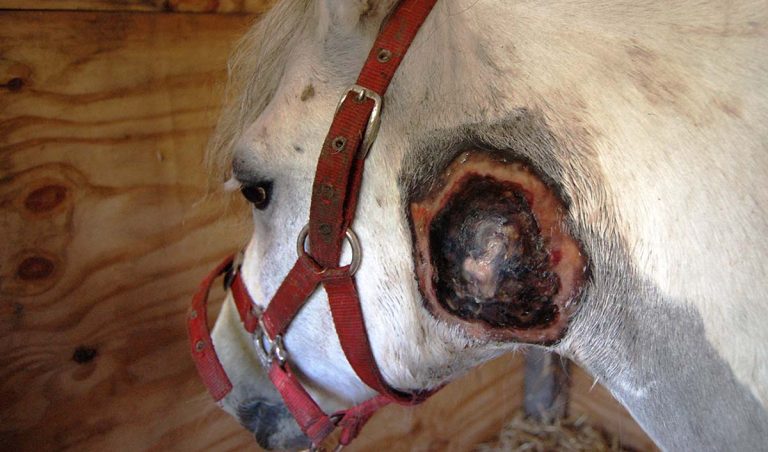Strangles:
Synonyms: Distemper, Infectious adenitis
- It is an acute infectious disease of equines characterized by catarrhal inflammation of URT with suppuration and abscessation of the associated lymph nodes.

Etiology:
- Streptococcus equi
- Gram +ve coccus
- Bacteria is very resistant and may remain alive for several months in purulent discharges.
- Fresh exudates can be sterilized by 5% cresol or 5% NaOH or heating at 90°C.
Epidemiology:
- Disease was widely prevalent in previous decades but of late, this has receeded to a greater extent.
- Horses suffer much more severely than donkeys or mules.
- Young horses within age group of 6 months to 36 months are most susceptible.
- Naïve or non-immune horses in a population have a high risk of infection, with morbidity rates potentially reaching 100%.
- The disease spreads quickly in environments where horses are housed in close proximity, such as stables, riding schools, and equestrian gatherings.
- Recent research has highlighted the extent of the problem within Ireland, estimating that over 40% of horses in Ireland have been exposed to this disease and may be chronic carriers of infection.
- It is estimated that up to 10% of horses may die due to complications of severe infection.
- Furthermore, up to 10% of affected animals may develop a chronic carrier state which results in intermittent shedding of the contagious bacteria.
Transmission:
- Nasal discharge of the infected animals is most important source of disease transmission.
- Ingestion of contaminated materials
- Droplet infection is also possible.
- Disease may be transmitted by stallion through copulation or to foal during suckling
- Transmission also takes place from fomites; e.g. feeding utensils, buckets, etc.
Pathogenesis:

Clinical Findings:
- Incubation period ranges from 2-5 days.
- High rise of temperature, profound depression
- Animal reluctant to move, eat or drink.
- There is nasal discharge which ranges from serous to mucopurulent and finally purulent.
- Cough is evident due to pharyngitis and laryngitis
- Inflammatory swelling of submaxillary lymph glands
- Formation of abscess in lymph glands which burst out releasing large quantities of thick yellowish or white or creamy pus.
- Bronchopneumonia results due to extension of infection from guttural pouches.
- Horse may stand with an outstretched neck to assist breathing and relieve lymph node pain
- Difficulty swallowing and breathing may occur due to the enlargement of lymph nodes
- Constipation followed by diarrhoea
- Scanty urine with increased album
- Purpura haemorrhagica may develop in a small number of horses 2-4 weeks after strangles
PM Findings:
- Edema and congestion of nasal mucus membrane
- Abscess formation in pharyngeal and submaxillary lymph nodes.
- Empyema of guttural pouch
- Changes in pleura and pericardium.
Diagnosis:
- Based on clinical findings and PM findings
- Isolation of streptococcus equi in affected horses.
- PCR testing
- Hematology: Increased neutrophil
- Immunodiagnostic test: ELISA, Passive HA
Differential Diagnosis:
- Glanders:
- Nasal discharge is usually thick, sticky, yellow-green
- Multiple nodules/ulcers in nasal mucosa
- Disease progress slowly and often fatal if untreated
- Equine influenza:
- Sudden high fever, dry hacking cough
- Rapid spread; no lymph node abscesses
- Equine viral arteritis (EVA):
- Conjunctivitis,
- Edema of limbs/scrotum,
- Serous to mucopurulent nasal discharge, but lymph node abscesses uncommon.
- Equine Herpesvirus-1/4 (EHV-1/4) respiratory form
- Pharyngitis, sometimes neurologic or reproductive signs
- Lymphadenopathy less suppurative
Treatment:
- Since the organism is gram +ve, penicillin is the drug of choice.
- Crystalline penicillin @ 10 million units is given through IM route
- Drugs like tetracycline may also be tried @10 mg/kg, b.wt.
- Pus materials from nose, eye, etc. should be carefully mopped with antiseptic solution.
- Benzathine penicillin (30 000 IU per kg IM q 2 days), or feed supplementation with low levels of tetracycline (60–80 ppm feed) are very effective in preventing or stopping an outbreak.
- Supportive therapy of strangles includes twice-daily cleansing of draining sites and nostrils, application of fly repellants, and provision of high quality soft, moist feed.
- Guttural pouch infections may require irrigation with surgical antiseptic or penicillin solutions.
- Horses that develop purpura hemorrhagica includes corticosteroids to reduce leukocytes response.
- Edematous legs should be bandaged.
- Blood transfusion may be indicated in cases with anemia or thrombocytopenia.
Control Measures:
- Due to contagious nature of disease and rapid spread, animals with clinical signs should be isolated immediately.
- Contaminated premises should be thoroughly disinfected. Beddings should be burnt.
- Animals with contact may be immunized passively by injecting immune serum SC at dose of 200-300 ml for few days consecutively.
- Freeze dried vaccine may be given to susceptible animals for active immunization. Foals upto 6 months of age; 4 injections at 10-14 days interval consisting 1ml, 2ml, 4ml, and 8ml, through SC or IM route.
- Foal upto 6 months to 2 years of age: 4ml, 8ml, 16ml SC or IM at 10-14 days interval.
- Regular temperature checks should be performed every 12 hours to detect feverish animals and separate them to prevent spread.
- Newly purchased horses should be isolated for 4 weeks before introduction into herd.
- Good hygiene and biosecurity in the yard are vital to minimize infections. Stressors like overcrowding should be avoided.
- Maintaining disinfection of equipment and stables between horses to minimize spread of disease.